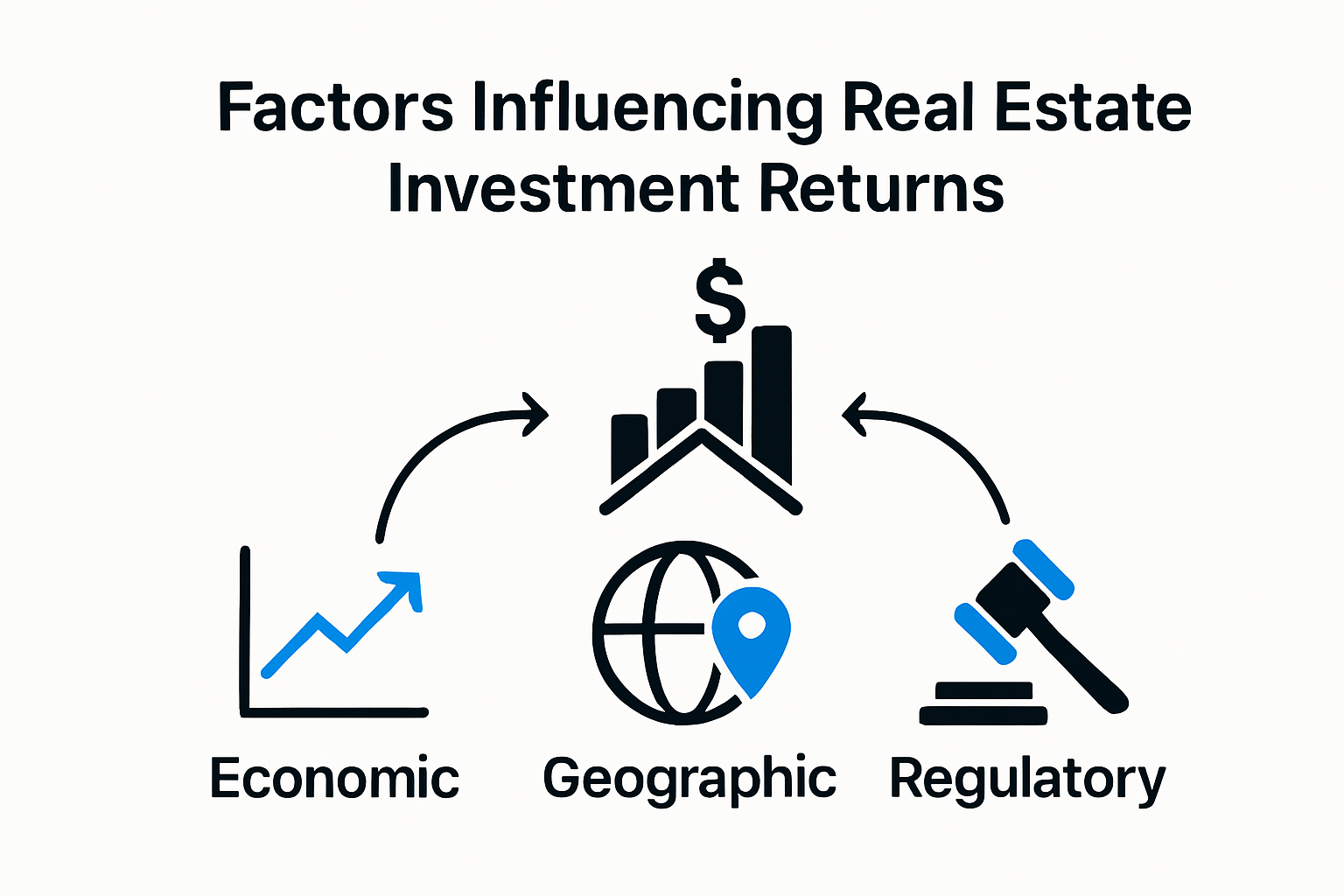
Real estate investors are watching 2025 with cautious optimism. Some locations are seeing property values rise up to 12 percent in a single year, outpacing average global returns by nearly double. Surprised? High returns are not just about picking the right city or predicting inflation. The real secret lies in overlooked strategies and hidden pitfalls that most investors completely miss.
Table of Contents
- What Influences Real Estate Investment Returns
- Key Metrics For Measuring Returns
- Strategies To Maximize Property Income
- Common Mistakes And How To Avoid Them
Quick Summary
| Takeaway | Explanation |
|---|---|
| Economic Indicators Matter | Real estate investment returns closely correlate with macroeconomic factors like inflation, employment rates, and GDP growth, which influence property values and demand. |
| Location is Key | A thorough analysis of geographical and location-specific factors, including infrastructure, population growth, and economic diversity, is crucial for identifying profitable investment opportunities. |
| Measure Performance with Metrics | Investors should employ key metrics such as Net Operating Income (NOI), Capitalization Rate (Cap Rate), and Cash-on-Cash Return to accurately assess property performance and make informed decisions. |
| Avoid Common Mistakes | Investors must steer clear of over-leveraging and emotional decision-making while conducting diligent market research to prevent costly errors and sustain long-term returns. |
| Enhance Property Value | Strategic property improvements, tenant selection, and exploring alternative income streams can significantly boost rental income and overall property value. |
What Influences Real Estate Investment Returns
Understanding the complex dynamics of real estate investment returns requires a comprehensive analysis of multiple interconnected factors. Investors seeking robust and sustainable returns must look beyond surface-level metrics and dive deep into the fundamental elements that drive property value and potential profitability.

Economic Fundamentals and Market Performance
Real estate investment returns are intrinsically linked to broader economic indicators. Macroeconomic factors such as inflation rates, unemployment levels, and gross domestic product growth play a critical role in determining the potential success of real estate investments. Savvy investors recognize that economic stability directly correlates with property market performance.
Inflation, in particular, presents a unique opportunity for real estate investors. As currency values fluctuate, real estate often serves as a hedge against economic uncertainty. Properties tend to appreciate in value during inflationary periods, providing investors with a potential buffer against diminishing purchasing power. This characteristic makes real estate an attractive option for those seeking to protect and grow their wealth.
Unemployment rates also significantly impact real estate investment returns. Regions with stable job markets and growing employment tend to demonstrate stronger demand for housing and commercial properties. When local economies thrive, real estate markets typically experience increased demand, driving property values and rental income potential upward.
Geographical and Location-Specific Factors
Location remains the most critical determinant of real estate investment returns. Investors must conduct thorough research into specific geographical markets, understanding local economic trends, infrastructure development, and demographic shifts. explore our comprehensive investment guide to gain deeper insights into location-specific investment strategies.
Key location-specific factors include:
- Infrastructure Development: Areas experiencing significant infrastructure improvements often see substantial property value increases.
- Population Growth: Regions with consistent population expansion typically maintain stronger real estate markets.
- Local Economic Diversity: Markets with multiple economic sectors tend to demonstrate more resilient property investment returns.
Beyond broad geographical considerations, micro-level location attributes such as proximity to amenities, transportation networks, and emerging commercial zones dramatically influence investment potential. Investors who understand these nuanced location dynamics can identify opportunities before they become mainstream.
Regulatory and Legal Considerations
The regulatory environment plays a pivotal role in shaping real estate investment returns. Investors must carefully assess legal frameworks, taxation policies, and potential legislative changes that could impact property investments. Transparent and investor-friendly legal systems provide greater confidence and reduce potential risks associated with real estate transactions.
Property ownership regulations, foreign investment policies, and tax structures can significantly alter the risk-reward profile of real estate investments. Comprehensive due diligence becomes paramount for investors seeking to maximize returns while mitigating potential legal complications.
Successful real estate investors approach their strategy with a holistic perspective, recognizing that investment returns emerge from a complex interplay of economic, geographical, and regulatory factors. By maintaining a comprehensive understanding of these dynamics, investors can make informed decisions that align with their financial objectives and risk tolerance.
Key Metrics for Measuring Returns
Real estate investment returns demand precise measurement and comprehensive analysis. Investors seeking sustainable financial growth must master key performance metrics that provide clear insights into property investment potential and actual returns.
Performance Evaluation Fundamentals
Understanding investment performance requires a strategic approach to financial measurement. Successful investors utilize multiple metrics to create a holistic view of their real estate investments. These metrics help translate complex financial data into actionable intelligence, enabling more informed decision-making.
Net Operating Income (NOI) stands as a fundamental metric for evaluating property performance. This calculation represents the total revenue generated by a property minus its operational expenses, excluding mortgage payments and capital expenditures. A robust NOI indicates a property’s core earning potential and operational efficiency. Investors use this metric to assess the underlying financial health of their real estate assets.
The Capitalization Rate (Cap Rate) provides another critical perspective on investment performance. Calculated by dividing a property’s annual net operating income by its current market value, the cap rate offers a quick snapshot of potential return on investment. Higher cap rates typically suggest greater potential returns, though they often correlate with higher risk levels.
Advanced Return Calculation Methods
Sophisticated investors go beyond basic metrics to develop a more nuanced understanding of investment performance. Cash-on-Cash Return emerges as a powerful tool for measuring annual returns relative to the initial cash investment. This metric calculates the annual pre-tax cash flow divided by the total cash invested, providing a clear picture of actual monetary performance.
Total Return on Investment (ROI) represents a comprehensive approach to measuring investment success. This metric encompasses multiple value drivers, including:
- Appreciation: Increase in property market value
- Rental Income: Annual revenue generated from property leasing
- Tax Benefits: Potential deductions and financial advantages
- Equity Build-up: Reduction of loan principal through rental income
learn more about advanced investment strategies for maximizing your returns.
Risk-Adjusted Performance Analysis
Investors must move beyond raw numbers to understand risk-adjusted performance. The Sharpe Ratio provides a sophisticated method of comparing investment returns against potential risks. This metric helps investors understand the true efficiency of their investment strategy by measuring returns relative to the volatility experienced.
Debt Service Coverage Ratio (DSCR) offers critical insights for leveraged real estate investments. By comparing a property’s annual net operating income to its total debt obligations, investors can assess the property’s ability to generate sufficient income to cover loan payments. A DSCR above 1.25 typically indicates a financially robust investment with lower default risk.
Ultimately, successful real estate investment requires a multifaceted approach to performance measurement. Investors who develop a comprehensive understanding of these metrics can make more strategic decisions, balancing potential returns with calculated risk management. Continuous learning and adaptive analysis remain key to navigating the complex landscape of real estate investment returns.
To help clarify the various investment metrics discussed in this section, the following table summarizes the purpose and key features of each:
| Metric | What It Measures | Key Use |
|---|---|---|
| Net Operating Income (NOI) | Total revenue minus operational expenses | Assess baseline earning power |
| Capitalization Rate (Cap) | NOI divided by market value | Snapshot of potential return |
| Cash-on-Cash Return | Annual pre-tax cash flow / total cash invested | Measure liquid return |
| ROI (Total Return) | Overall returns including appreciation, etc. | Gauge comprehensive success |
| Sharpe Ratio | Return relative to risk/volatility | Risk-adjusted performance |
| DSCR | NOI divided by annual debt service | Debt coverage ability |
Strategies to Maximize Property Income
Maximizing property income requires a strategic and proactive approach that goes beyond basic rental collection. Successful real estate investors understand that sustainable income generation demands continuous improvement, market understanding, and intelligent investment in property assets.
Rental Strategy Optimization
Effective rental strategies form the cornerstone of maximizing property income. Investors must develop a sophisticated approach that balances competitive pricing with value-driven offerings. This involves conducting comprehensive market research to understand local rental trends, demographic preferences, and pricing dynamics.
Setting the right rental price requires nuanced analysis. Pricing too high can lead to extended vacancy periods, while pricing too low reduces potential income. Successful investors utilize dynamic pricing models that adjust rates based on seasonal demand, local economic conditions, and specific property attributes. Regular market comparisons and periodic rate assessments ensure that rental prices remain competitive and reflective of current market conditions.
Tenant selection plays a critical role in income stability. Implementing rigorous screening processes helps identify reliable tenants who are more likely to pay consistently and maintain the property. Background checks, employment verification, and credit assessments minimize the risk of rental defaults and reduce potential income disruptions.
Property Value Enhancement
Strategic property improvements directly correlate with increased rental income and overall property value. Targeted renovations and upgrades can significantly boost a property’s market appeal and justify higher rental rates. Focus on improvements that provide measurable returns on investment.
Key value-enhancing strategies include:
- Modern Kitchen Upgrades: Renovations that improve functionality and aesthetic appeal
- Energy Efficient Installations: Reducing utility costs and attracting environmentally conscious tenants
- Smart Home Technology: Adding contemporary features that increase property attractiveness
- Outdoor Space Improvements: Creating additional living areas that differentiate the property
explore financing options for property improvements to accelerate your investment potential.
Maintenance plays a crucial role in preserving and enhancing property value. Proactive maintenance prevents costly repairs and demonstrates commitment to property quality. Regular inspections, prompt repair responses, and preventative maintenance strategies protect the property’s long-term value and tenant satisfaction.

Diversification and Income Streams
Advanced investors recognize the importance of creating multiple income streams from their real estate investments. Beyond traditional long-term rentals, consider alternative revenue generation strategies that maximize property potential.
Alternative income opportunities include short-term vacation rentals, offering furnished spaces for remote workers, and exploring mixed-use property configurations. These strategies can help diversify income sources and mitigate risks associated with single-stream rental models.
Tax optimization strategies can also contribute to net income improvement. Understanding local tax regulations, leveraging depreciation benefits, and strategically structuring property ownership can help minimize tax liabilities and improve overall financial returns.
Successful property income maximization requires a holistic approach. Investors must remain adaptable, continuously educate themselves about market trends, and be willing to adjust strategies in response to changing economic landscapes. By combining strategic thinking, proactive management, and continuous improvement, real estate investors can create robust and sustainable income streams from their property investments.
To provide a helpful overview, here’s a summary table of property income maximization strategies and their key features:
| Strategy | Purpose | Key Actions/Considerations |
|---|---|---|
| Dynamic Pricing | Optimizes rent based on market & demand | Adjust rates seasonally/locally |
| Rigorous Tenant Screening | Income stability & property care | Employment, background, credit checks |
| Value-Enhancing Renovations | Increase rental rates & attract tenants | Kitchen, energy-efficiency, smart tech, etc. |
| Preventative Maintenance | Preserve value, reduce future costs | Regular inspections/repairs |
| Rental Model Diversification | Increase/differentiate income streams | Short-term, remote worker, mixed-use rentals |
| Tax Optimization | Improve net/income after taxes | Depreciation, ownership structure |
Common Mistakes and How to Avoid Them
Real estate investment presents significant opportunities, but success hinges on avoiding critical errors that can derail financial goals. Understanding and preempting common pitfalls becomes crucial for investors seeking sustainable returns and long-term wealth generation.
Financial Misjudgments and Overextension
Financial miscalculation represents one of the most dangerous mistakes investors encounter. Overleveraging emerges as a primary risk, where investors commit excessive borrowed funds without comprehensive financial planning. This approach creates vulnerability to market fluctuations and potentially devastating financial consequences.
Budget miscalculation frequently undermines investment strategies. Many investors fail to account for comprehensive expenses beyond basic purchase and rental costs. Hidden expenses such as maintenance, property management, insurance, and unexpected repairs can significantly erode potential returns. Successful investors develop detailed financial models that include contingency funds and anticipate potential additional costs.
Understanding personal financial limits becomes paramount. Investors must rigorously assess their risk tolerance and maintain sufficient liquidity to weather potential market downturns. This approach requires honest self-assessment and disciplined financial management, preventing emotional decision-making that could compromise long-term investment objectives.
Due Diligence and Market Understanding
Insufficient market research represents another critical mistake that can sabotage real estate investment returns. Investors who neglect comprehensive market analysis expose themselves to significant risks. This research extends beyond surface-level property evaluations, demanding deep understanding of local economic trends, demographic shifts, and potential future development.
Key areas requiring thorough investigation include:
- Local Economic Indicators: Employment rates, economic diversity, and growth potential
- Regulatory Environment: Zoning laws, property regulations, and potential legislative changes
- Demographic Trends: Population growth, migration patterns, and evolving housing preferences
discover comprehensive investment research strategies to minimize potential risks.
Neglecting professional guidance compounds research challenges. Many investors underestimate the complexity of real estate markets, attempting to navigate intricate processes without expert consultation. Engaging local real estate professionals, legal experts, and financial advisors provides critical insights that can prevent costly mistakes.
Emotional Decision-Making and Strategic Errors
Emotional investing represents a subtle yet destructive mistake that undermines rational decision-making. Investors who become attached to properties or make decisions based on personal preferences rather than objective financial metrics often experience suboptimal returns.
Common emotional traps include:
- Falling in love with a property’s aesthetic appeal
- Refusing to sell underperforming assets
- Overestimating personal renovation capabilities
- Ignoring objective market data
Successful investors cultivate a disciplined, data-driven approach that separates emotional attachment from strategic financial planning. This requires developing robust decision-making frameworks that prioritize measurable financial metrics over subjective impressions.
Ultimately, avoiding common real estate investment mistakes demands continuous learning, professional guidance, and a commitment to comprehensive research. Investors who approach real estate with strategic thinking, financial discipline, and objective analysis position themselves for sustainable success in an increasingly complex investment landscape.
Frequently Asked Questions
What factors influence real estate investment returns in 2025?
Real estate investment returns in 2025 are influenced by economic fundamentals like inflation, unemployment, and GDP growth, along with geographical factors such as infrastructure development and local market conditions.
How can I measure the performance of my real estate investments?
You can measure the performance of real estate investments using key metrics such as Net Operating Income (NOI), Capitalization Rate (Cap Rate), and Cash-on-Cash Return, alongside advanced methods like Total Return on Investment (ROI) and the Sharpe Ratio for risk-adjusted analysis.
What strategies can maximize my property income in 2025?
To maximize property income, consider optimizing rental pricing based on market conditions, enhancing property value through strategic renovations, and diversifying income streams with alternative rental options like short-term leases or mixed-use properties.
What common mistakes should I avoid when investing in real estate?
Common mistakes include over-leveraging your finances, insufficient due diligence regarding market conditions, and making emotional decisions rather than relying on data. Ensuring careful financial and market analysis can help you avoid these pitfalls.
Unlock High-Yield Real Estate Returns in Costa Rica—No Traditional Bank Required
Expanding your real estate investment portfolio is challenging, especially when facing tight lending criteria and competitive markets. This article explores how maximizing returns, mastering key investment metrics, and avoiding common pitfalls can help expats and investors succeed in 2025. But when traditional financing limits your options or slows your progress, it is easy to miss out on prime opportunities in thriving markets like Costa Rica.

You do not have to let financing barriers stop your growth. At Costa Rica Loan Experts, we provide fast, flexible collateral-backed loans tailored for expats, property owners, and investors who want to capture strong returns now. Looking to earn 12–18 percent secured yields or need private real estate funding with transparent terms? Start exploring your options by visiting our specialized private lending platform. Take the next step with confidence—discover how your real estate strategy can thrive in Costa Rica’s dynamic 2025 market.
Recommended
- Expat Property Financing in 2025: Smart Strategies and Tips – costaricaloanexperts.net
- expat property financing – costaricaloanexperts.net
- Real Estate Investment Returns Costa Rica: 2025 Guide for Investors – costaricaloanexperts.net
- real estate investment returns Costa Rica – costaricaloanexperts.net
- Real Estate Backed Investments in 2025: Safe Passive Income for Expats & Investors – costaricaloanexperts.net
- real estate backed investments – costaricaloanexperts.net
